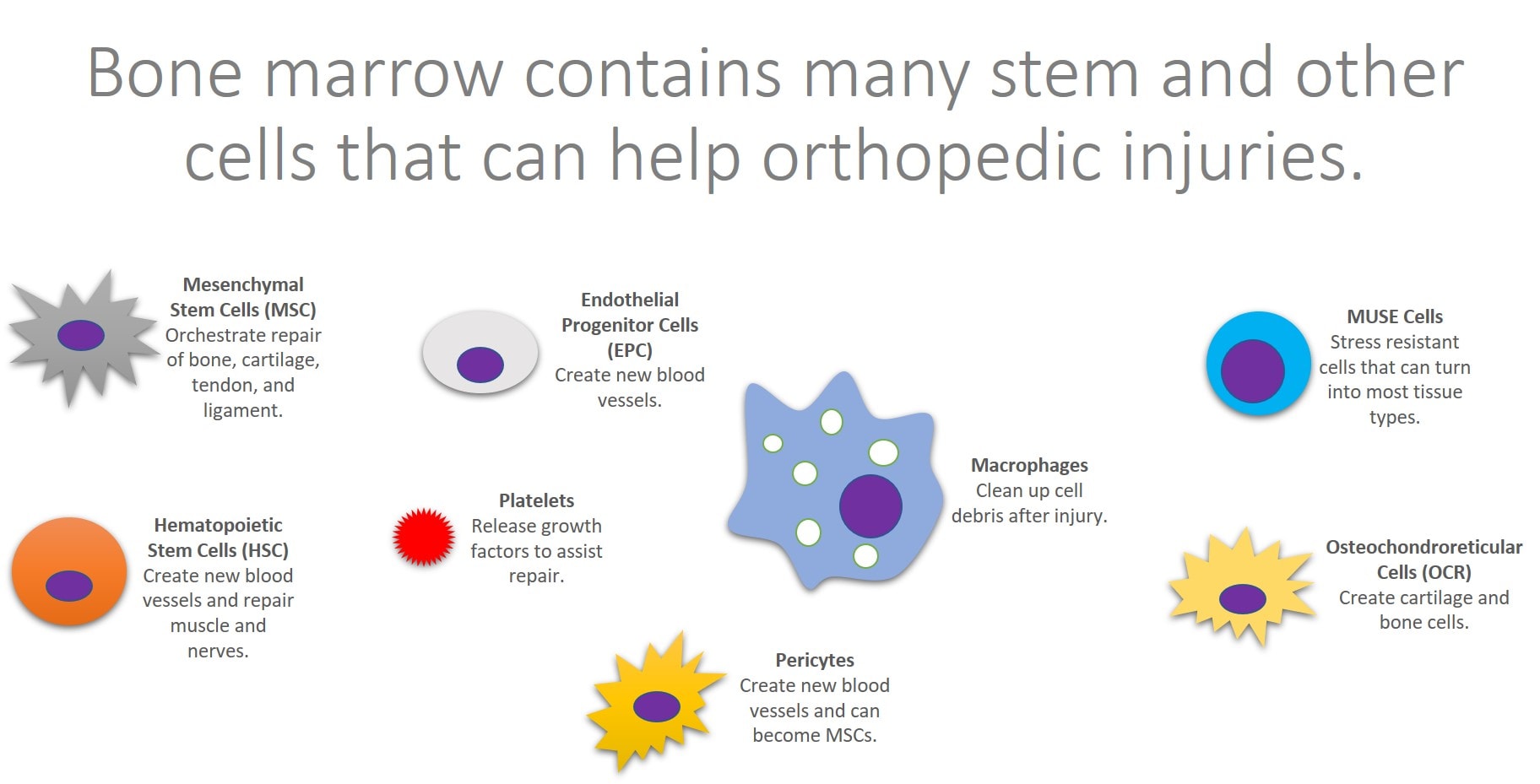Seems We Have More Bone Marrow Stem Cells than We Thought—Way More!
How many stem cells live in your body? It would likely surprise you that we really don’t yet know for sure. We do know that your bone marrow has many of those cells. We also know that it has many different types of cells that make other cells. But how many make exactly which type of cell has been harder to track, until now.
What Types of Cells Are in Your Bone Marrow that Can Help Repair Tissue?
Cells that can help repair tissue, like stem cells and others, live in many different places in your body. They reside in your bone marrow, fat, and, frankly, pretty much every tissue you have. This morning, we’ll focus on only your bone marrow.
Below is my illustration of the many different types of cells that live in your bone marrow that are involved in the repair of orthopedic tissues:
Stem Cells and Stem Cell Differentiation
Stem cells are the body’s primary self-repair system, and they accomplish this in a number of different ways. The most common, and probably familiar, way a stem cell repairs cells, however, is to replace them all together—this is done through a process known as differentiation. When a cell is dying, a local stem cell will detect a chemical signal and make two copies of itself (a progenitor cell and a reserve stem cell). The progenitor cell then observes its environment (other cells, pressure, chemicals, etc.) and transforms into the cell being replaced.
Learn more about stem cell differentiation in my brief video below:
Now, a new study, by tracing offspring blood cells back to their parent stem cells has found a way to determine the number of specific blood-producing, bone marrow stem cells in humans.
More Bone Marrow Stem Cells? Up to 200,000 Bone Marrow Stem Cells Producing WBCs
In order to quantify blood stem cells in humans (previously, these stem cell numbers had only been studied in animals), researchers conducted a new study in which they examined the blood and bone marrow of one healthy man (aged 59). They studied the individual genetic information in the subject’s blood cells and then grouped the cells (nearly 130,000 cells) in related families (140 colonies). They were then able to link each cell family to a stem cell parent (fascinatingly, this cellular family tree can also be traced all the way back to ancestor stem cells before birth). This allowed them to estimate the number of stem cell parents required to produce these active blood cell families.
The result? For example, they estimated that 50,000–200,000 stem cells are actively producing white blood cells (WBCs) at any given time, significantly more bone marrow stem cells focused on that one task than previously thought based on animal studies. This doesn’t include other stem cell types in the bone marrow. Why is this important? The more we learn about stem cells, the more we learn about certain diseases and the potential for repair and treatment.
More Fascinating Facts About Stem Cells and Repair
Stem cells also use another mechanism for repair—exosomes. Exosomes carry messenger RNA (mRNA) and live on the stem cell’s outer wall. The stem cell can coordinate repair by telling other cells what to do, and it does this by firing the mRNA-filled exosomes into the other cell, essentially commandeering the other cell. The mRNA carries the instructions from the stem cell that the other cell needs to start producing the proteins necessary to perform the repair job. Learn more about these in my short video below:
Stem cells can also directly repair cells by replacing the damaged “batteries” in worn out cells. What are these “batteries” exactly? Cells have a structure that is the central powerhouse (or energy source) for the cell known as mitochondria. Stem cells can directly replace these mitochondria when they have become weak or damaged.
Other ways stem cells accomplish repair include stopping good cells (e.g., clean-up cells, such as macrophages) that have gone bad from causing more damage, and calling in the right cells for the right repair job (i.e., paracrine signaling) and releasing growth factors (think espresso shots) to make them work extra hard.
The upshot? Your whole body is made up of cells that can help repair tissue. These are there to keep you alive, as you would literally die without them. This includes your bone marrow, which is where many of these cells live. Turns out, when it comes to performing specific tasks, like making a particular type of blood cell, there’s more than we thought!

If you have questions or comments about this blog post, please email us at [email protected]
NOTE: This blog post provides general information to help the reader better understand regenerative medicine, musculoskeletal health, and related subjects. All content provided in this blog, website, or any linked materials, including text, graphics, images, patient profiles, outcomes, and information, are not intended and should not be considered or used as a substitute for medical advice, diagnosis, or treatment. Please always consult with a professional and certified healthcare provider to discuss if a treatment is right for you.
